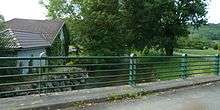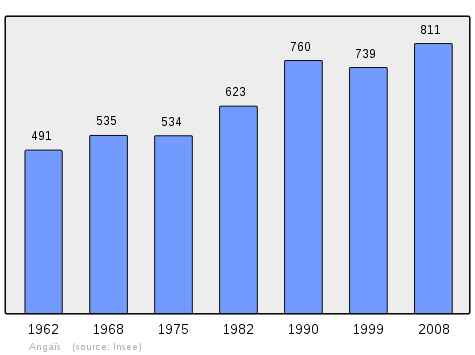Angaïs
| Angaïs | |
|---|---|
|
| |
 Angaïs | |
|
Location within Nouvelle-Aquitaine region  Angaïs | |
| Coordinates: 43°14′19″N 0°15′05″W / 43.2386°N 0.2514°WCoordinates: 43°14′19″N 0°15′05″W / 43.2386°N 0.2514°W | |
| Country | France |
| Region | Nouvelle-Aquitaine |
| Department | Pyrénées-Atlantiques |
| Arrondissement | Pau |
| Canton | Nay-Est |
| Intercommunality | Pays de Nay |
| Government | |
| • Mayor (2008–2020) | Bernard Arrabie |
| Area1 | 5.94 km2 (2.29 sq mi) |
| Population (2010)2 | 836 |
| • Density | 140/km2 (360/sq mi) |
| Time zone | CET (UTC+1) |
| • Summer (DST) | CEST (UTC+2) |
| INSEE/Postal code | 64023 / 64510 |
| Elevation |
214–412 m (702–1,352 ft) (avg. 235 m or 771 ft) |
|
1 French Land Register data, which excludes lakes, ponds, glaciers > 1 km² (0.386 sq mi or 247 acres) and river estuaries. 2 Population without double counting: residents of multiple communes (e.g., students and military personnel) only counted once. | |
Angaïs (Occitan: Angais, pronounced [aŋˈɡajs]) is a French commune in the Pyrénées-Atlantiques department in the Nouvelle-Aquitaine region of south-western France.
The inhabitants of the commune are known as Angaïsais or Angaïsaises.[1]
Geography
Angaïs is located in the urban area of Pau some 12 km south-east of Pau and 6 km south of Ousse. Access to the commune is by the D38 road from Ousse in the north-west passing through the town and continuing south to Baudreix. The D215 comes from near Assat in the west passing through the town and continuing south-east to Beuste. The D938 passes through the south-western corner of the commune and the D839 from Boeil-Bezing forms the southern border of the commune. The north-east of the commune is heavily forested for about 25% of the total land area with the rest of the commune outside the town area farmland.
Bus route 835 of the Interurban Network of Pyrenees Atlantiques from Bénéjacq to Pau services the commune.

The Lagoin river flows through the centre of the commune from south-east to north-west continuing to join the Gave de Pau near Pau.
Places and Hamlets
- Abérat[2]
- Las Baches
- Bonnecaze
- Boué Bignes
- Las Clabades
- Coulat
- Grange de Cournac
- Lafont
- Grange Laraignou
- Le Moulin de Capbat
- Papus
- Pascal
- La Roque
- Turounet
Neighbouring communes and villages
 |
Assat | Artigueloutan | Nousty |  |
| Bordes | |
Lucgarier | ||
| ||||
| | ||||
| Boeil-Bezing | Baudreix | Beuste |
Toponymy
The commune name in béarnais is Angais.
Brigitte Jobbe-Duval[3] indicated that a possible origin of the name is the patronym Gaiz. She also mentioned that previously the people were nicknamed éleveurs de mules (Mule farmers). The breeding of these animals had been one of the most productive industries of the Nay plain and particularly of the commune of Angaïs.[4]
The following table details the origins of the commune name and other names in the commune.
| Name | Spelling | Date | Source | Page | Origin | Description |
|---|---|---|---|---|---|---|
| Angaïs | Angays | 1343 | Raymond | Homages | Village | |
| Anguays | 1540 | Raymond | Reformation | |||
| Angais | 1750 | Cassini | ||||
| Angais | 1793 | Ldh/EHESS/Cassini | Bulletin des Lois | |||
| Abérat | Averat | 1457 | Raymond | Assat | Fief, vassal of the Viscounts of Béarn | |
| Batbielle | Baigbiella | 13th century | Raymond | Fors de Béarn | Lands and Woods across the communes of Angaïs, Beuste, Boeil, Bénéjacq, Bordères, Lagos, and Mirepeix under the jurisdiction of the Jurors of Beuste. It was an Archdeaconry in the Diocese of Lescar and included control over the Canton of Nay | |
| Archidiagonat de Batbilhe | 1385 | Raymond | Census | |||
| Batbielhe | 1396 | Raymond | Navarrenx | |||
| l'archidiagonat de Begbielle | 1400 | Raymond | Navarrenx | |||
| Le conbent de Bagbielhe | 1538 | Raymond | Reformation | |||
| Les Abbatbielles | 1675 | Raymond | Reformation | |||
| Navailles | Navailles | 1863 | Raymond | Farm |
Sources:
- Raymond: Topographic Dictionary of the Department of Basses-Pyrenees, 1863, on the page numbers indicated in the table. (French)[2]
- Cassini: Cassini Map from 1750[5]
- Ldh/EHESS/Cassini: Ldh/EHESS/Cassini database (French)
Origins:
- Homages: Homages of Béarn[6]
- Reformation: Reformation of Béarn[7]
- Assat:[8]
- Fors de Béarn[9]
- Census: Census of Béarn[9]
- Navarrenx: Notaries of Navarrenx[10]
History
Paul Raymond noted on opage 6 of his 1863 dictionary that the commune once had a Lay Abbey, vassal of the Viscounts of Béarn. In 1385 there were 4 fires in the commune and it depended on the bailiwick of Pau.[2]
On 2 February 1617 Louis de Colom, lay abbot of Angaïs and a trustee of Béarn, made an important speech which united the Catholics and Protestants of Béarn to resist the king's wishes, and to oppose the execution of any act that may lead to political annexation of Béarn to France. Later in the same year the First Huguenot Rebellion occurred.[11]
The Barony of Angaïs was created in 1656 by Louis XIV[12] and consisted of Beuste, Ousse, and Sendets.[2]
Isaac de Navailles appears to have been the first Baron, and Henri de Navailles-Labatut was Baron of Angaïs in the mid-19th century.[13][14]
The Uzerte of Angaïs refers to a local phenomenon of plague that was documented in 1789. The inhabitants of Angaïs stated that almost every year the plague was transported by very clear water - which rose above the village on the plain on the upper side of the wooded area - in April, May, and June. It caused fatal diseases in humans and animals. The poisoned water also harmed plants, such as maize, wheat, flax, grass, and vegetables in gardens.[4]
Administration
List of Successive Mayors[15]
| From | To | Name | Party | Position |
|---|---|---|---|---|
| 1995 | 2001 | Pierre Prat | ||
| 2001 | 2020 | Bernard Arrabie |
(Not all data is known)
Inter-communality
The commune is part of six inter-communal structures:
- the Community of communes of Pays de Nay;
- the AEP association of the Plain of Nay;
- the Sanitation association of Gave and Lagoin;
- the association for defence against flooding in the Lagoin basin;
- the Energy association of Pyrénées-Atlantiques;
- the inter-communal association for the construction of the CES of Nay;
Demography
In 2010 the commune had 836 inhabitants. The evolution of the number of inhabitants is known from the population censuses conducted in the commune since 1793. From the 21st century, a census of communes with fewer than 10,000 inhabitants is held every five years, unlike larger towns that have a sample survey every year.[Note 1]
| 1793 | 1800 | 1806 | 1821 | 1831 | 1836 | 1841 | 1846 | 1851 |
|---|---|---|---|---|---|---|---|---|
| 568 | 562 | 624 | 661 | 744 | 789 | 785 | 851 | 875 |
| 1856 | 1861 | 1866 | 1872 | 1876 | 1881 | 1886 | 1891 | 1896 |
|---|---|---|---|---|---|---|---|---|
| 853 | 865 | 830 | 802 | 783 | 787 | 757 | 730 | 716 |
| 1901 | 1906 | 1911 | 1921 | 1926 | 1931 | 1936 | 1946 | 1954 |
|---|---|---|---|---|---|---|---|---|
| 697 | 671 | 637 | 560 | 561 | 537 | 511 | 467 | 460 |
| 1962 | 1968 | 1975 | 1982 | 1990 | 1999 | 2006 | 2010 | - |
|---|---|---|---|---|---|---|---|---|
| 491 | 535 | 534 | 623 | 760 | 739 | - | 836 | - |
Sources : Ldh/EHESS/Cassini until 1962, INSEE database from 1968 (population without double counting and municipal population from 2006)

Economy
The commune is part of the Appellation d'origine contrôlée (AOC) zone of Ossau-Iraty.
Culture and heritage
Civil heritage
- The Château of Angaïs (1908)
 is registered as an historical monument.[16]
is registered as an historical monument.[16]
Religious heritage
- The Parish Church of Notre-Dame (1845)
 is registered as an historical monument.[17] Inside the church the Altar and Retable (17th century)
is registered as an historical monument.[17] Inside the church the Altar and Retable (17th century) in the south side chapel are registered as historical objects.[18]
in the south side chapel are registered as historical objects.[18]
Environmental heritage
The Chemin Henri-IV borders the commune in the north-east. It is a walking trail that connects the Château of Franqueville to Bizanos near Pau at the Lake of Lourdes (Hautes-Pyrénées). It alternates forest trails with dirt roads and offers walkers panoramic views of the Pyrenees, the foothills, and the plains.
About 35 kilometres long, the route can be divided up between the various roads that it crosses. It is possible to go on foot, on horseback, or by bicycle but motor vehicles are forbidden.
Education
The commune has a primary school.
See also
Notes
- ↑ At the beginning of the 21st century, the methods of identification have been modified by Law No. 2002-276 of 27 February 2002, the so-called "law of local democracy" and in particular Title V "census operations" allows, after a transitional period running from 2004 to 2008, the annual publication of the legal population of the different French administrative districts. For communes with a population greater than 10,000 inhabitants, a sample survey is conducted annually, the entire territory of these communes is taken into account at the end of the period of five years. The first "legal population" after 1999 under this new law came into force on 1 January 2009 and was based on the census of 2006.
References
- ↑ Inhabitants of Pyrénées-Atlantiques (French)
- 1 2 3 4 Topographic Dictionary of the Department of Basses-Pyrenees, Paul Raymond, Imprimerie nationale, 1863, Digitised from Lyon Public Library 15 June 2011 (French)
- ↑ Brigitte Jobbé-Duval, Dictionary of place names - Pyrénées-Atlantiques, 2009, Archives and Culture, ISBN 978-2-35077-151-9 (French)
- 1 2 Lespy, Vastin (1892). Dictons et proverbes du Béarn: parœmiologie comparée (in French) (Public domain ed.). Garet. pp. 5–. Retrieved 28 April 2012.
- ↑ Cassini Map 1750 – Angaïs
- ↑ Manuscript from 1343 in the Departmental Archives of Pyrénées-Atlantiques (French)
- ↑ Manuscript from the 16th to 18th centuries - Departmental Archives of Pyrénées-Atlantiques (French)
- ↑ Notaries of Assat in the Departmental Archives of Pyrénées-Atlantiques (French)
- 1 2 Manuscript from the 14th century - Departmental Archives of Pyrénées-Atlantiques (French)
- ↑ Société historique de Gascogne (1887). Revue de gascogne: bulletin bimestrial de la société historique de Gascogne (in French). 28 (Public domain ed.). Auch. pp. 254–. Retrieved 28 April 2012.
- ↑ Ch. de Picamilh (1858). Statistique generale des Basses-Pyrinees. Vignancour. p. 516. Retrieved 28 April 2012.
- ↑ A. Dufau de Maluquer. Armorial de Béarn (tome 2). PyréMonde (Ed.Régionalismes). p. 78. ISBN 978-2-84618-626-1. Retrieved 28 April 2012.
- ↑ d'Hauterive, André F. Borel (1846). Annuaire de la pairie et de la noblesse de France et des maisons souveraines de l'Europe et de la diplomatie. Bureau de la Publ. p. 223. Retrieved 28 April 2012.
- ↑ List of Mayors of France (French)
- ↑ Ministry of Culture, Mérimée PA64000036 Château of Angaïs (French)
- ↑ Ministry of Culture, Mérimée IA64000583 Parish Church of Notre-Dame (French)
- ↑ Ministry of Culture, Palissy PM64000030 Altar and Retable (French)
External links
- Angaïs on Lion1906
- Angais on the 1750 Cassini Map
- Angaïs on the INSEE website (French)
- INSEE (French)
| Wikimedia Commons has media related to Angaïs. |